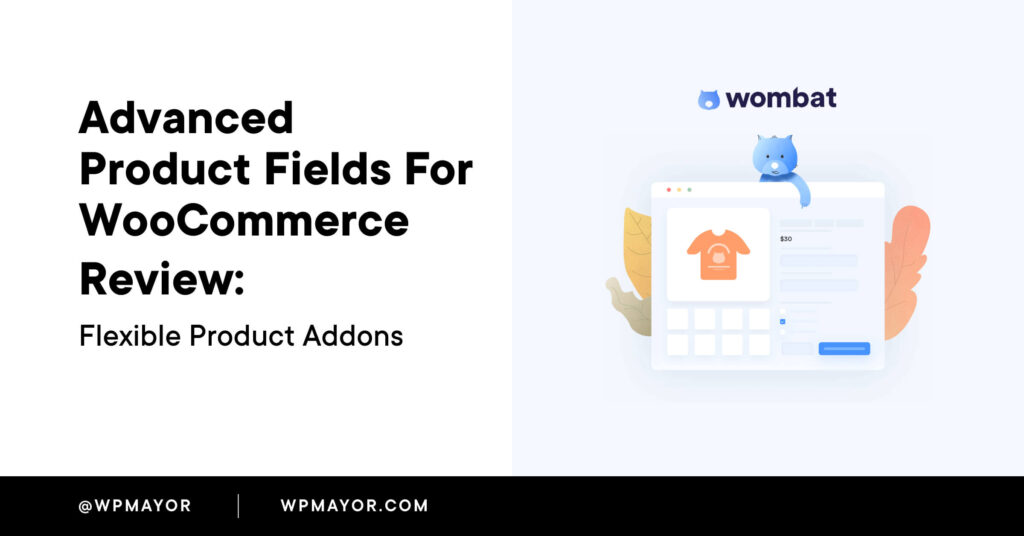[ad_1]
Need to add custom fields to your WooCommerce products?
Custom fields, often called product addons, let you collect additional inputs from your customers. You can use these to create all types of customizable products and give shoppers more flexibility than the native WooCommerce options allow.
Advanced Product Fields for WooCommerce is a freemium plugin that gives you a ton of functionality for adding custom fields to WooCommerce products.
You can choose from 16+ different field types, adjust prices in tons of ways, use conditional logic, and more.
In our hands-on Advanced Product Fields for WooCommerce review, we’ll tell you more about what the plugin does and give you a hands-on look at how it works.
Advanced Product Fields for WooCommerce Review: A Look at the Features

In a nutshell, the core value of Advanced Product Fields for WooCommerce is that it lets you add extra fields/options to your products.
You can collect additional inputs from your customers and also adjust the price of the product up or down based on those inputs.
You can use this to sell pretty much any type of customizable product. Here are a few examples (but this is by no means a complete list):
- Framed prints – let people choose the frame and upload the photo that they want to use.
- Wallpaper – let shoppers enter the dimensions that they want and use those to calculate the price.
- Custom t-shirts – let people choose a color and upload their own image or slogan to print on the shirt.
- Made-to-order food – if you’re using WooCommerce as a restaurant ordering system, you can let people customize their dishes, such as choosing the toppings for a pizza.
Here’s an example of a business card product with lots of different product fields:
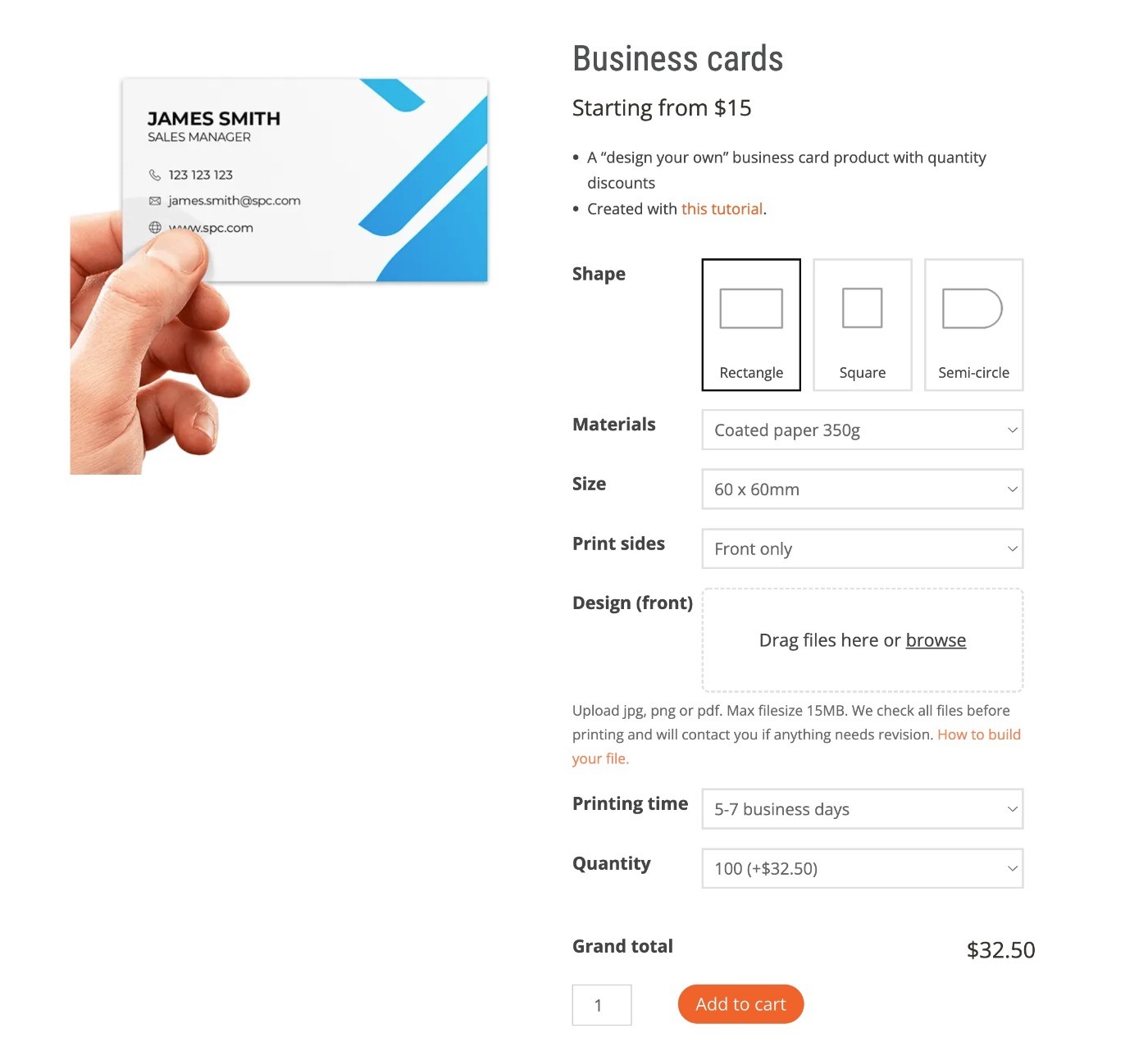
If you want to see some live examples, the Advanced Product Fields for WooCommerce demo site has a bunch of examples of different types of products. You can even check out their blog post on selling business cards with WooCommerce.
Obviously, with a plugin like this, most of the value is in the nitty-gritty features/options that it offers, so let’s go through those features in more depth.
16+ Different Field Types
Across the free and paid version, you get access to 16+ different field types that you can use on your products.
Here are the nine free field types:
- Text field (single line)
- Text area (multi line)
- URL
- Number
- Select (drop-down)
- Checkboxes
- Radio buttons
- True/false
And here are the premium field types:
- File upload – let customers upload one or more files (e.g. images). There’s also an add-on that adds image processing functionality.
- Color swatches – e.g. let people choose the color of something by showing the actual color as an option.
- Image swatches.
- Text swatches.
- Date (calendar picker).
- Content fields – you can use these to add extra content to your products (they don’t accept input from customers). You get paragraph, image, and section fields.
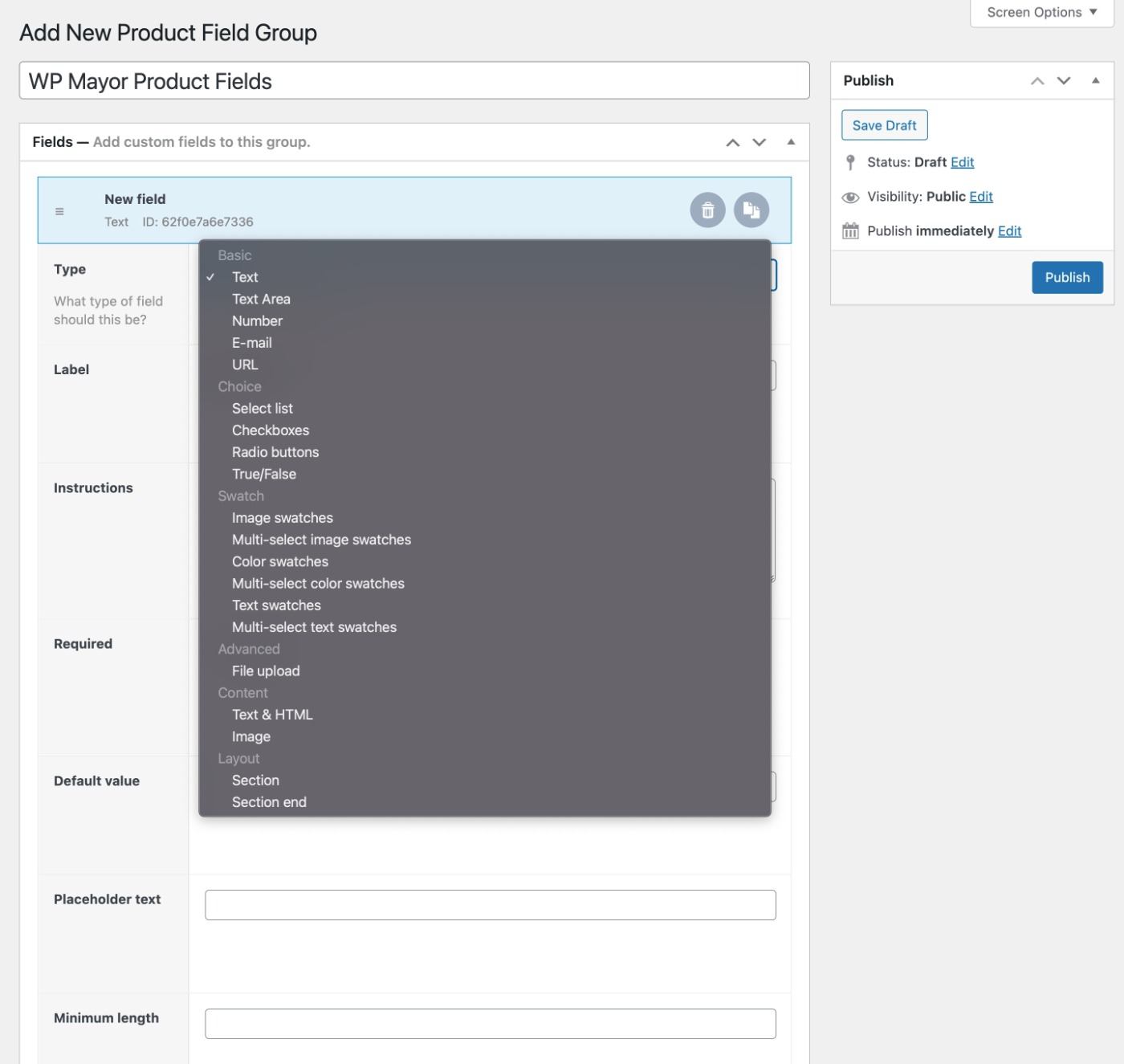
You can also use conditional logic to show or hide fields based on the values of other fields.
Beyond that, you can use quantity-based options to increase the number of options based on a user’s chosen quantity.
Finally, you can attach your product options to individual products or set up rules to bulk apply product add-ons to some or all of your products.
Adjust Prices Up or Down
You can use each option to adjust the price of a product up or down.
For example, let’s go back to the wallpaper example. You could have people enter the length and height and then calculate the price based on that.
You could also charge for other flat add-ons in addition to the calculated price.
Alternatively, you can also discount the price based on a shopper’s inputs.
Here are the many pricing formulas that you can use:
- Flat fee.
- Quantity-based price.
- Percentage-based fee.
- Formula-based price – you can literally create your own mathematical pricing formulas based on user inputs. E.g. calculate the square meterage based on given height/width and multiply that by the price per square meter.
- Character length-based pricing – this is great for engravings or other similar use cases.
- Value-based pricing.
Useful Integrations
Advanced Product Fields for WooCommerce integrates with a lot of the other plugins you might be using:
- WOOCS integration for multi-currency stores.
- WPML and Polylang integrations for multilingual stores (it should also work with frontend translation tools like TranslatePress and Weglot).
- WooCommerce Subscriptions to use product addons for subscription products.
- WooCommerce Product Table, which we’ve written about a lot. It also integrates with that developer’s WooCommerce Quick View Pro plugin.
- Advanced Custom Fields (ACF) to use ACF fields in formula-based pricing.
Other Notable Features
Beyond those specific features above, the plugin has lots of other useful features:
- Ajax add to cart support for themes that offer this feature.
- Live content preview so that shoppers can preview their text or images on the product’s images.
- Layered images – you can use image layers to showcase your products and allow for easy customization/previews.
- WooCommerce tax settings support.
- Show/hide product fields on cart/checkout – you can also let shoppers edit product fields on the cart page.
How to Use Advanced Product Fields for WooCommerce
Now that you know what Advanced Product Fields for WooCommerce does, let’s take a look at what it’s like to use the plugin on your WooCommerce store.
The plugin lets you add fields at two different levels:
- You can create field groups and use rules to add these fields to one or more products in bulk.
- You can add fields directly to the product via the Edit Product screen.
I’ll start by showing you how it works with field groups and then I’ll show you the direct option at the end, which offers similar options.
1. Configure Basic Settings
Before you start setting up product fields, you can access a few general settings by going to WooCommerce → Settings → Product fields.
For example, you can choose whether to show fields on the cart and checkout pages, as well as a few basic settings.
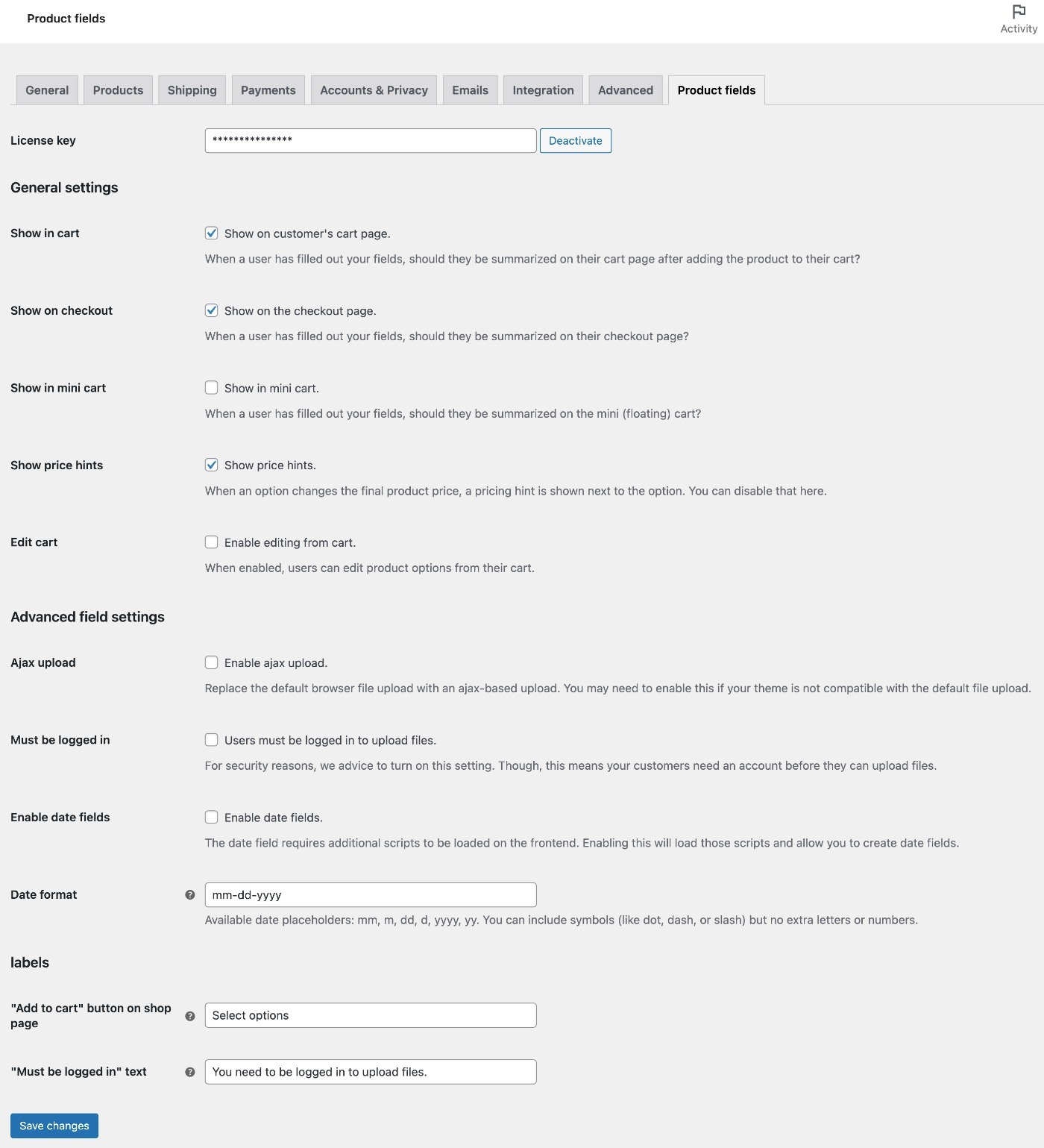
There’s not a lot here, though, because you’ll do most things from a different interface.
2. Create a Product Field Group
Each group of product fields that you want to display is called a Product Field Group. If you’re familiar with the Advanced Custom Fields plugin (ACF), this terminology will sound familiar as ACF also calls them “field groups”.
To create one, you’ll head to WooCommerce → Product Fields → Add New.

Here, the ACF similarities continue as the interface pretty much looks exactly like ACF (that’s a positive, as I find ACF to be very easy to use).
3. Add Fields
Next, you can add the individual fields that you want to include in your group.
When you add a field, you’ll first use the drop-down to choose the field type. Then, you can configure the settings that relate to that type of field:

For example, if you choose the color swatches option, you can add all of the colors that you want to use (via a color picker), adjust the size and shape, and so on.
These settings are also where you can set up basic pricing rules.
For example, for the color swatches, you can see that I’m also able to assign a price adjustment (up or down) to each color:
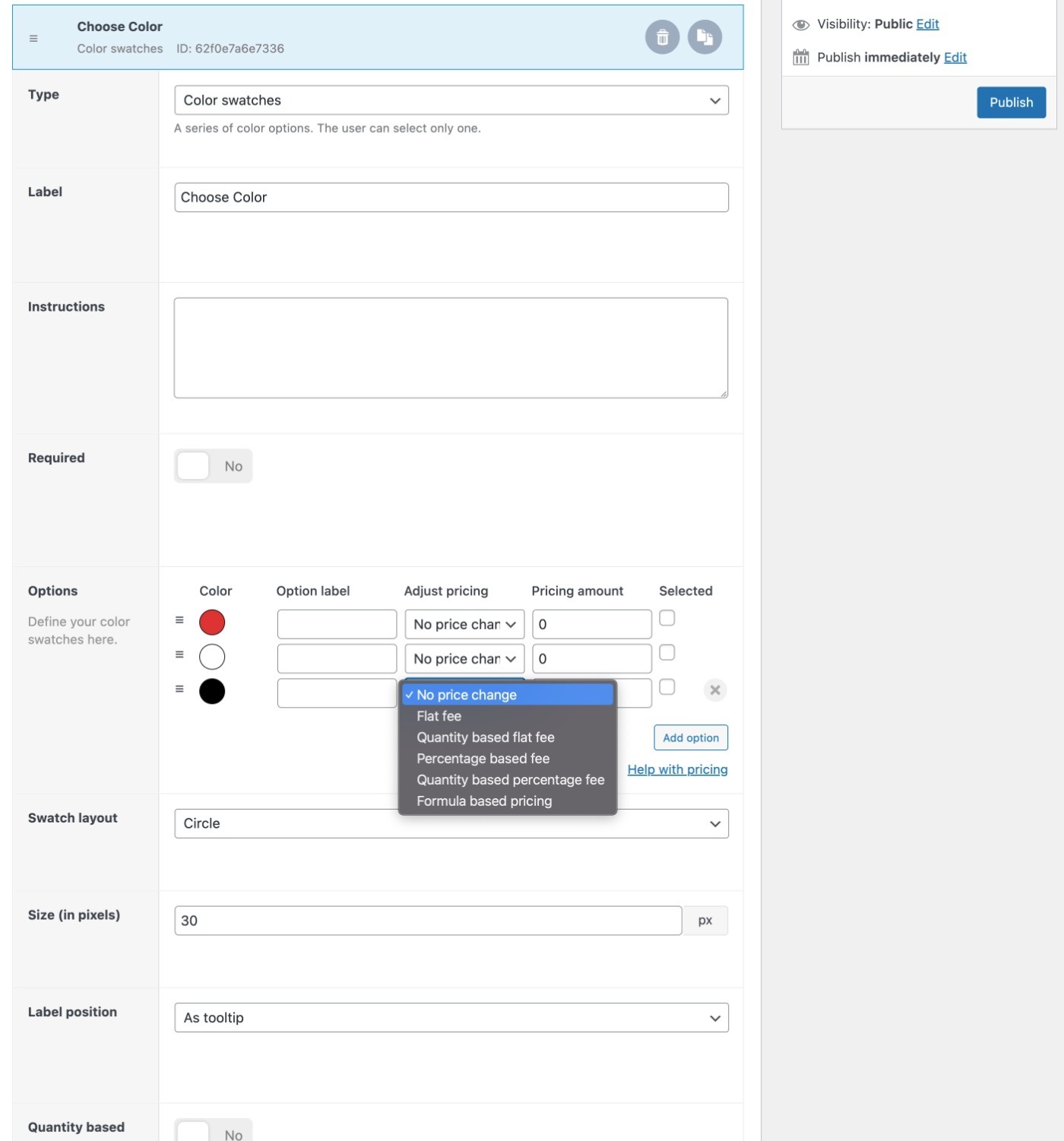
It’s the same idea for other fields.
For example, with the file upload field, you can choose the accepted file types, set a max size, and adjust pricing if needed.
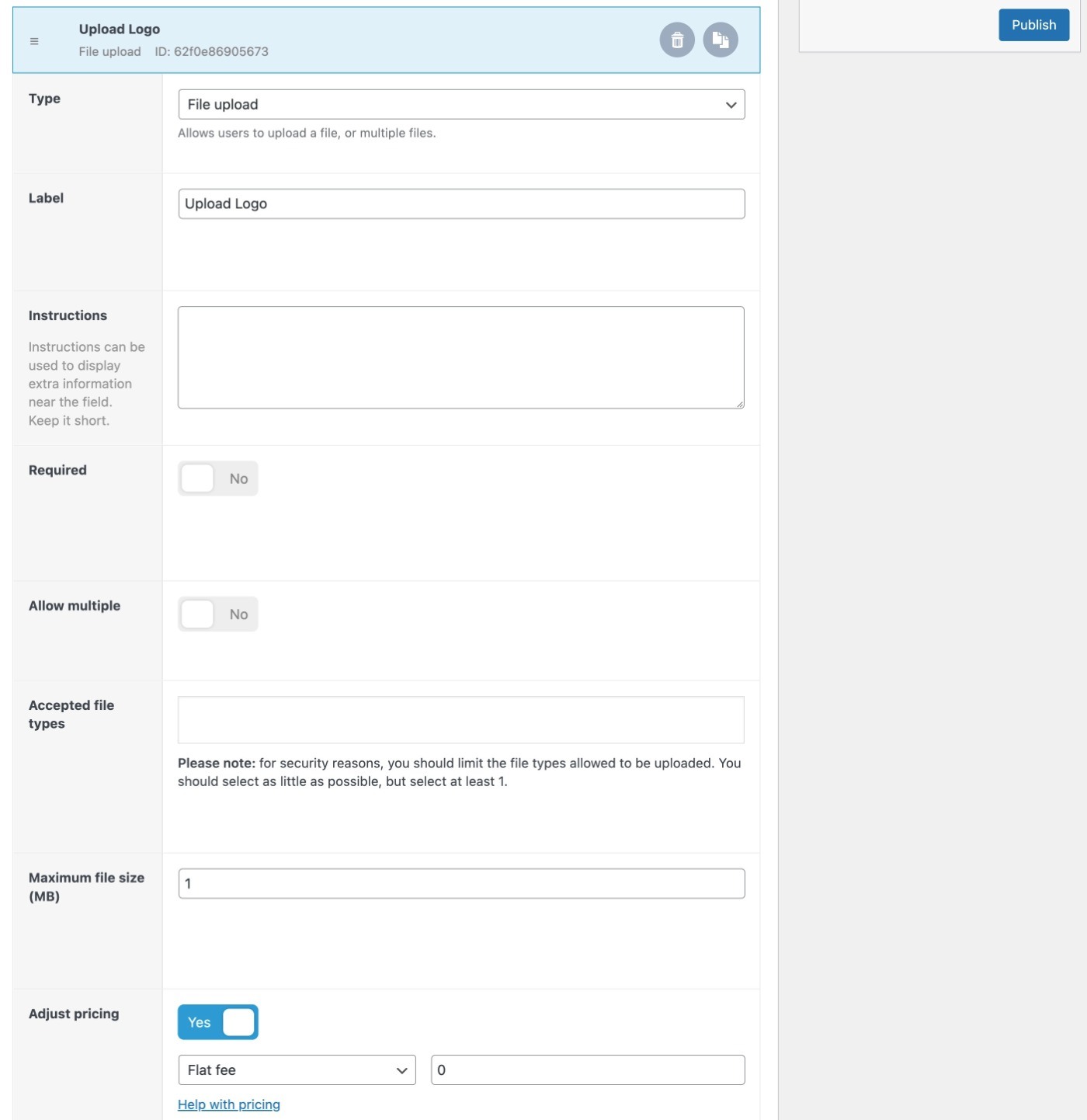
Beyond pricing, you can also make two other important choices for each field:
- Quantity based – you can show multiple field inputs (of this specific field) if a customer adds multiple items (using the native WooCommerce quantity picker).
- Conditional logic – you can use conditional logic to show/hide this field.
Here’s what those look like:
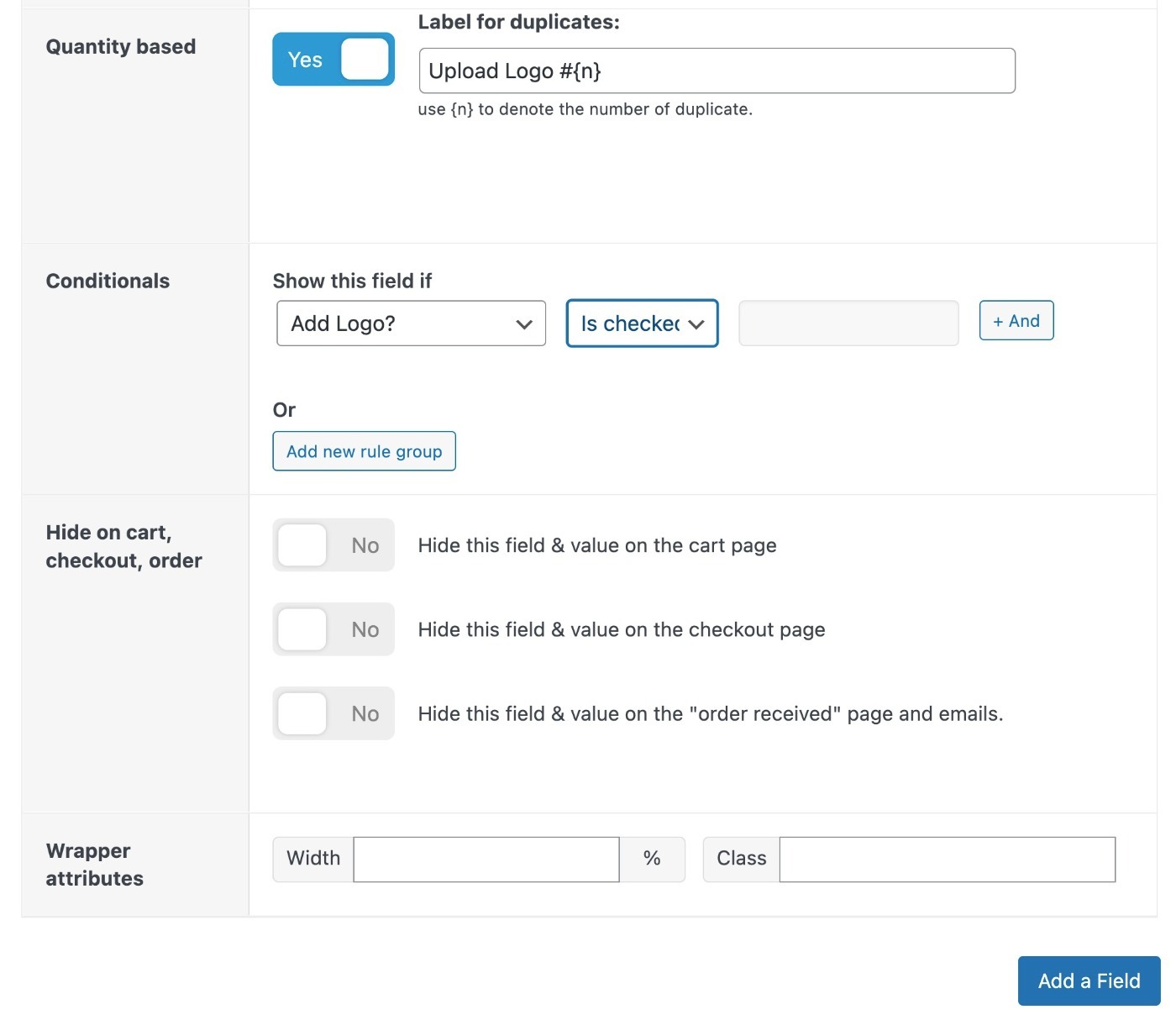
4. Create Display Conditions
Once you’ve added your fields, you can use Conditions to control which products you want to attach this field group to.
Your display rules can be as broad or as targeted as you want – you could display them on every single product, on individual products (or variations), or anywhere in between.
Here are all of the product-specific options that you get:
- Product
- Product variation
- Product category
- Product attribute
- Product tag
- Product type
Beyond those rules, you can also target by two non-product conditions:
- Authentication – whether or not someone is logged in.
- User role – you can only display them to specific user roles. For example, if you have a special user role for wholesale customers, you could only display these product fields to those users.
The cool thing here, though, is that you can mix and match those rules as much as needed using both AND or OR conditions.
For example, you could display them on:
- Products in the “Widget” category AND users with the “Wholesale” user role
- OR the Blue widget product (regardless of role)
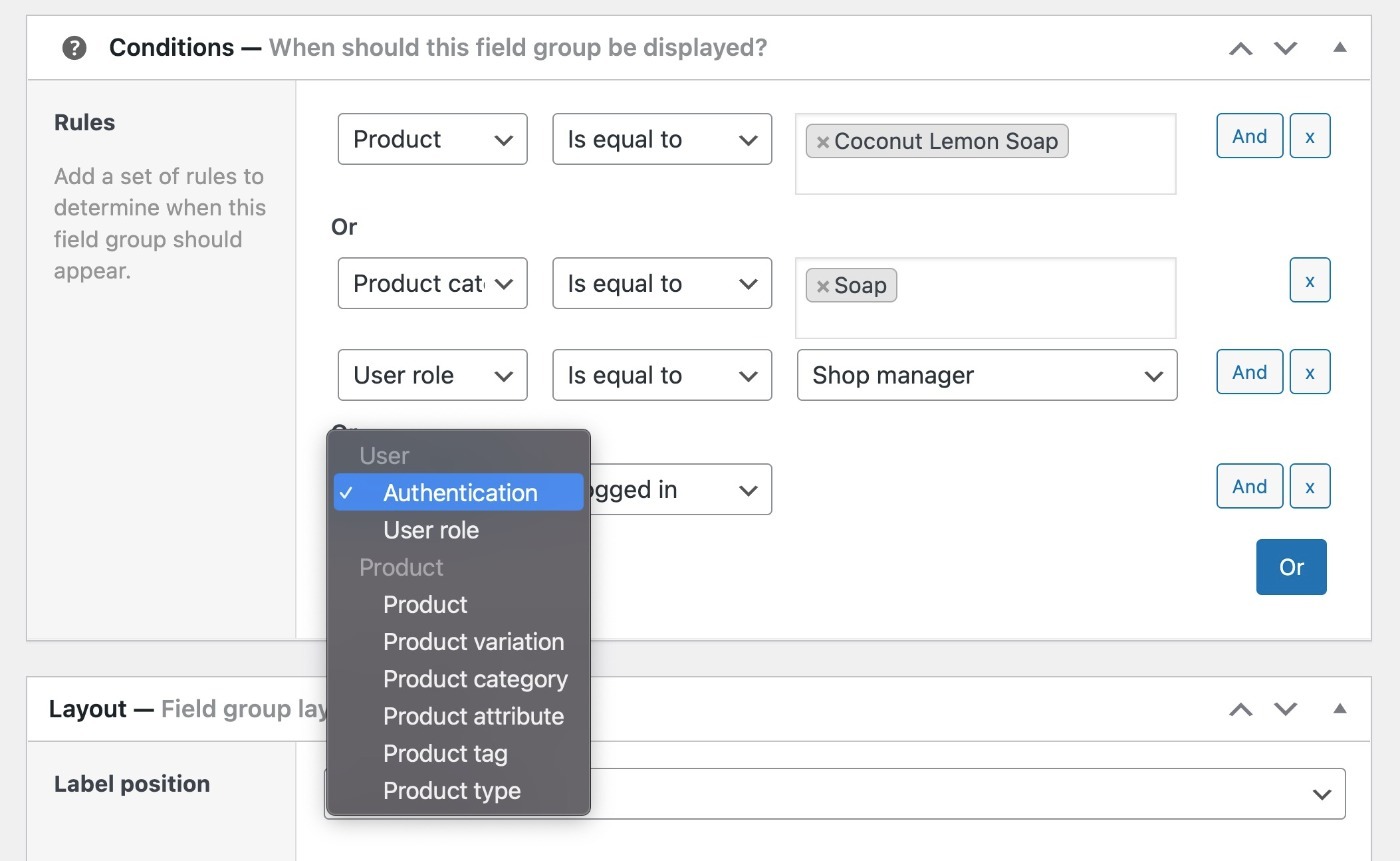
5. Configure Layout Settings
Below the conditions, you can set up layout settings for your field group. One of the most useful features here is the ability to change the product image based on a user’s choices.
If you enable this, you can set up your own rules to control when to show various product images:
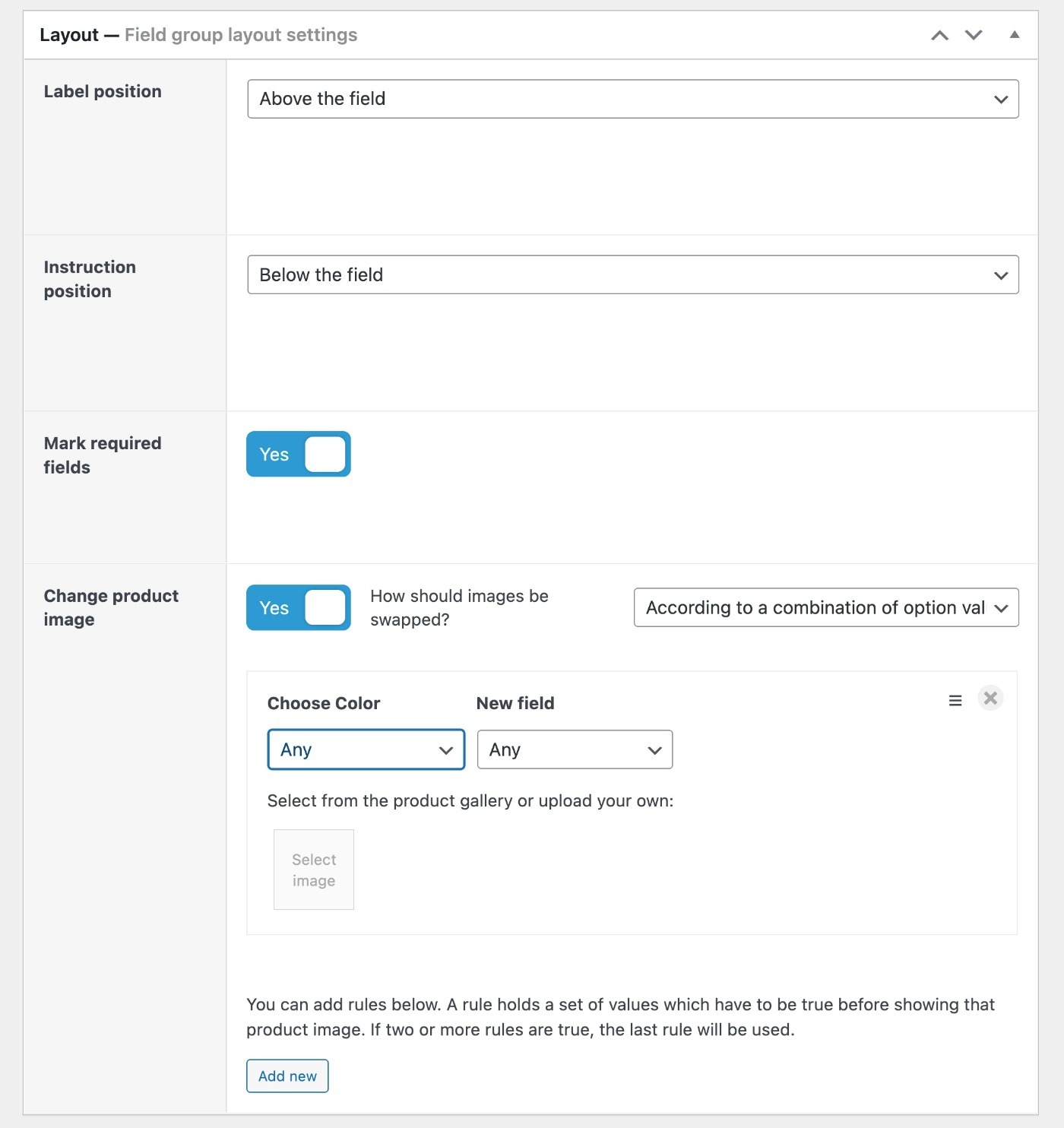
6. Set Up Custom Pricing Variables (Optional)
Finally, you have the option to set up custom variables to use with formula-based pricing.
You might not need to do anything here because you can already set up basic price adjustments when adding your fields. In fact, most people probably won’t need this feature.
In a nutshell, these custom variables let you get more creative and insert field inputs into an actual pricing formula.
For example, if you’re selling wallpaper, you could accept the height and width as inputs. Then, you could create a formula that calculates the square meterage and then multiply that by the price per square centimeter.
Here’s what the formula might look like:
([field.5e8ecdf46ea7d]*[x])*0.005
If you want to learn more, check out the full variables and formulas documentation page.
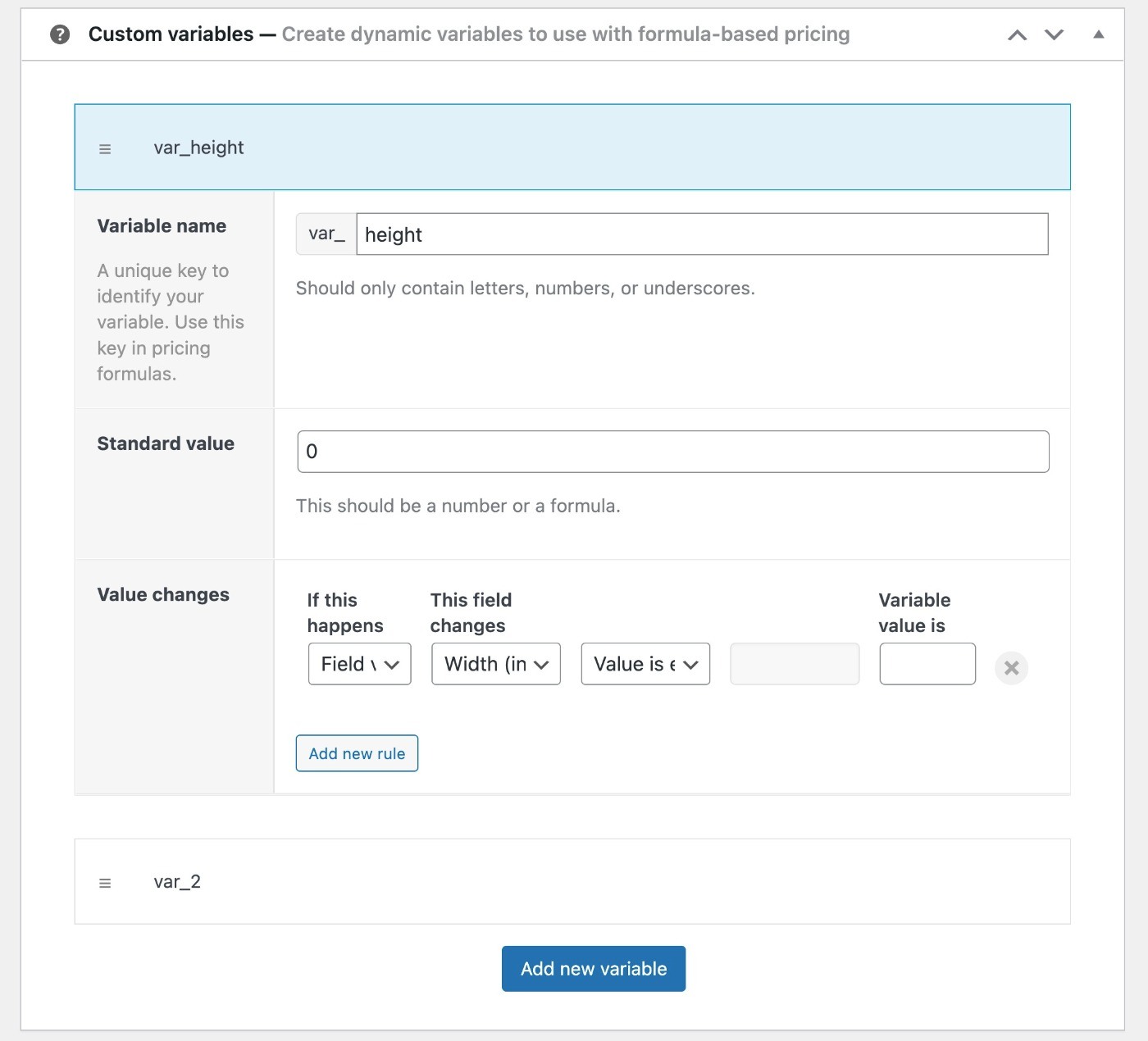
7. Publish Your Field Group
To finish things out, all you need to do is publish your field group.
It will then automatically display for all of the products that meet the conditions you chose.
Here, you can see some custom fields, along with the added price:

Add Custom Fields Directly to Products
In addition to creating field groups and applying them to products using conditions, the plugin also lets you add custom fields directly to products, which might be simpler in some cases.
You’ll get a new Custom fields tab in the Product data box that gives you a similar interface to add fields for just that product:

Advanced Product Fields for WooCommerce Pricing
Advanced Product Fields for WooCommerce comes in both a free version at WordPress.org as well as a premium version with more features.
Here are some of the main advantages of purchasing the premium version (this is not a full list of feature differences, though):
- More field types, such as file uploads and swatches.
- Content fields to add extra content to your product pages without accepting user input.
- Ajax add to cart support.
- More pricing options, including discounts.
- Quantity-based fields (add fields if visitors change product quantity).
If you want the premium version, the plans start at $59 for use on a single site with one year of support and updates or $159 for lifetime support and updates. Higher-tier plans include various add-ons and features.
Here are the full one-year license prices:
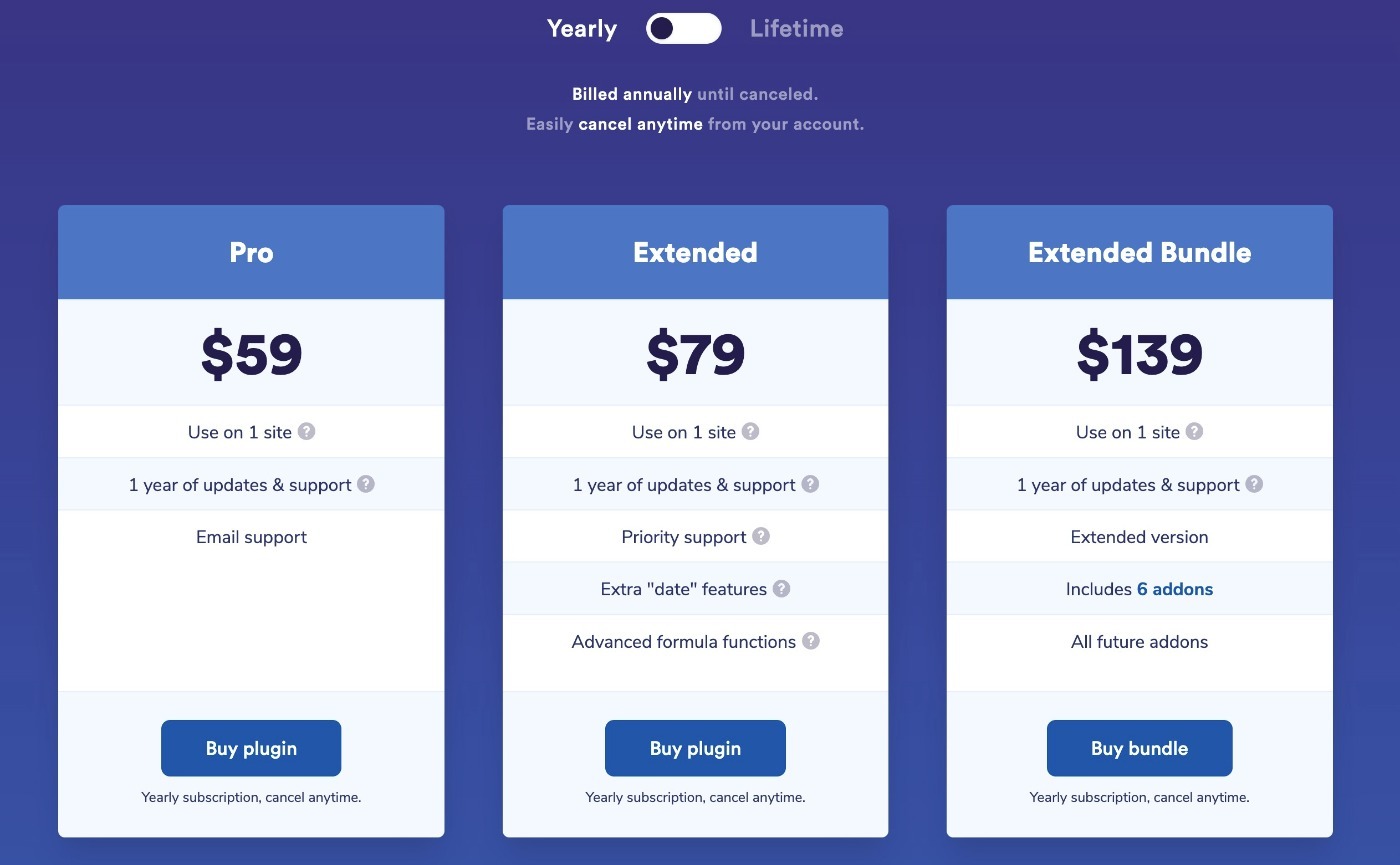
Here are the full lifetime license prices:

All plans come with a 14-day money-back guarantee.
Beyond the premium version, there are also some additional niche add-ons that you might want for certain use cases, such as using Advanced Custom Fields fields in formula-based pricing. You can view all of those add-ons by clicking here.
Final Thoughts on Advanced Product Fields for WooCommerce
Overall, I was impressed by the depth of functionality that Advanced Product Fields for WooCommerce offers.
You get a lot of flexibility, which helps the plugin work well for both simple product add-ons as well as more advanced setups with conditional logic, pricing formulas, and so on.
I also liked the interface a lot. As someone who’s used Advanced Custom Fields quite a bit, the plugin felt very familiar – just tailored to WooCommerce.
If ACF is part of your regular workflows, you’ll instantly feel at home with Advanced Product Fields for WooCommerce. And even if you’ve never used ACF, the interface is still very easy to pick up and organized logically.
If you want to try it out, you can install the free version from WordPress.org to access a lot of the functionality. Then, you can upgrade to the premium version to access all of the field types and features.
[ad_2]
Source link

